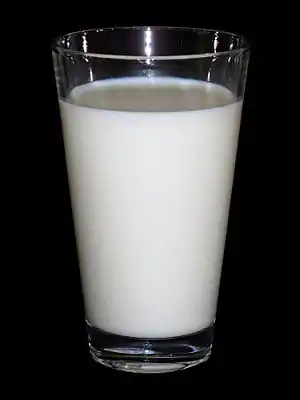Almond milk
Almond milk is a plant milk manufactured from almonds with a creamy texture and nutty flavor,[1] although some types or brands are flavored in imitation of dairy milk.[2] It does not contain cholesterol, saturated fat or lactose, and is often consumed by those who are lactose-intolerant and others, such as vegans, who avoid dairy products. Commercial almond milk comes in sweetened, unsweetened, vanilla and chocolate flavors, and is usually fortified with micronutrients. It can also be made at home using a blender, almonds and water.[3]
 | |||||||
| 15 kcal (63 kJ) | |||||||
| |||||||
Global almond milk sales in 2018 were US$5.8 billion, growing at 14% per year, and forecast to be a $13 billion global market by 2025.[4]
History
Almond milk was first invented in the Islamic Middle East and appears in cookbooks of the region from the 13th century onward, where it would later spread from the Levant to Europe.[5] In the Middle Ages, almond milk was known in both the Islamic world and Christendom. As a nut, almonds are permitted for consumption by these religions during fasting seasons, such as Lent and Ramadan. Historian Carolyn Walker Bynum notes that
medieval cookbooks suggest that the aristocracy observed fasting strictly, if legalistically. Meat-day and fish-day recipes were not separated in medieval recipe collections, as they were in later, better-organized cookbooks. But the most basic dishes were given in fast-day as well as ordinary-day versions. For example, a thin split-pea puree, sometimes enriched with fish stock or almond milk (produced by simmering ground almonds in water), replaced meat broth on fast days; and almond milk was a general (and expensive) substitute for cow's milk.[6]
In Persian cuisine, an almond milk based dessert called harireh badam (almond gruel) is traditionally served during Ramadan.[7]
Commerce
In the United States, almond milk remained a niche health food item until the early 2000s, when its popularity began to increase. In 2011 alone, almond milk sales increased by 79%.[8] In 2013, it surpassed soy milk as the most popular plant-based milk in the US.[9] As of 2014 it comprised 60 percent of plant-milk sales and 4.1 percent of total milk sales in the US.[10]:2–3
Within the Italian regions of Sicily, Apulia, Calabria, and Campania, almond milk is a protected traditional agricultural product.[11]
Nutrition
| Nutritional content of fortified cow, soy, almond and oat milks | ||||
|---|---|---|---|---|
| Nutrient value per 250 mL cup |
Cow milk (whole)[12] |
Soy milk (unsweetened)[13] |
Almond milk (unsweetened)[14] |
Oat milk (unsweetened)[15] |
| Energy, kJ (kcal) | 620 (149) | 330 (80) | 160 (39) | 500 (120) |
| Protein (g) | 7.69 | 6.95 | 1.55 | 3 |
| Fat (g) | 7.93 | 3.91 | 2.88 | 5 |
| Saturated fat (g) | 4.55 | 0.5 | 0 | 0.5 |
| Carbohydrate (g) | 11.71 | 4.23 | 1.52 | 16 |
| Fiber (g) | 0 | 1.2 | 0 | 2 |
| Sugars (g) | 12.32 | 1 | 0 | 7 |
| Calcium (mg)[lower-alpha 1] | 276 | 301 | 516 | 350 |
| Potassium (mg) | 322 | 292 | 176 | 390 |
| Sodium (mg) | 105 | 90 | 186 | 140 |
| Vitamin B12 (µg) | 1.10 | 2.70 | 0 | 1.2 |
| Vitamin A (IU)[lower-alpha 1][lower-alpha 2] | 395 | 503 | 372 | 267 |
| Vitamin D (IU)[lower-alpha 1][lower-alpha 3] | 124 | 119 | 110 | 144 |
| Cholesterol (mg) | 24 | 0 | 0 | 0 |
- Commonly added to plant milks, which do not naturally contain significant levels of the nutrient. Added to all three plant milks presented in this table.
- Vitamin A fortification is only required for skimmed milk in the US.
- Vitamin D fortification for dairy milk is mandatory in the US.
If unfortified, almond milk has less vitamin D than fortified cows' milk; in North America, cows' milk must be fortified with vitamin D, but vitamins are added to plant milks on a voluntary basis.[16] Because of its low protein content, almond milk is not a suitable replacement for breast milk, cows' milk, or hydrolyzed formulas for children under two years of age.[17]
Production
The general production method involves soaking and grinding almonds in an excess of water. A milky white liquid is obtained after filtering the almond pulp (flesh). Almond milk can also be made by adding water to almond butter. In commercial production, almond milk is homogenised with high pressure and pasteurised for greater stability and shelf life.[18]
In July 2015, a class action lawsuit was filed in New York City against two American manufacturers, Blue Diamond Growers and White Wave Foods, for false advertising regarding the small quantity of almonds (only 2%) contained in the final product.[19][20][21][22] In October 2015, a judge denied the plaintiff's request for an injunction.[23]
Sustainability
| Milk Types | Greenhouse Gas Emissions (kg CO2-Ceq per 200 g) |
|---|---|
| Cow's Milk | 0.62 |
| Rice Milk | 0.23 |
| Soy Milk | 0.21 |
| Oat Milk | 0.19 |
| Almond Milk | 0.16 |
| Milk Types | Land Use (m2 per 200 g) |
|---|---|
| Cow's Milk | 1.81 |
| Oat Milk | 0.25 |
| Soy Milk | 0.23 |
| Almond Milk | 0.19 |
| Rice Milk | 0.14 |
| Milk Types | Water Use (L/200 g) |
|---|---|
| Cow's Milk | 131 |
| Almond Milk | 74 |
| Rice Milk | 56 |
| Oat Milk | 9 |
| Soy Milk | 2 |
Almond production in California is concentrated mainly in the Central Valley,[25] where the mild climate, rich soil, and abundant sunshine and water supply make for ideal growing conditions. Due to the persistent droughts in California in the early 21st century, it became more difficult to raise almonds in a sustainable manner.[26][27]
Almond sustainability is challenged because of the high amount of water needed to grow almonds: a single glass of almond milk requires roughly 74 litres (16 imp gal; 20 US gal) of water to produce.[24] Among plant-based milks, almond milk requires substantially more water during the growing and production stages than soy, rice or oat milk (graph).[24] Cow's milk requires more water to produce than almond milk. In 2014, California produced 42.3 billion pounds of cow's milk and only 2.14 billion pounds of almond milk.[28][29]
Sustainability strategies implemented by the Almond Board of California and almond farmers include:[27][30][31]
- tree and soil health, and other farming practices
- minimizing dust production during the harvest
- bee health
- irrigation guidelines for farmers
- food safety
- use of waste biomass as coproducts with a goal to achieve zero waste
- use of solar energy during processing
- job development
- support of scientific research to investigate potential health benefits of consuming almonds
- international education about sustainability practices
See also
Other plant milks:
References
- Lincoln, Jamie (18 August 2016). "Ditching Dairy? Here's a Cheat Sheet to the Tastiest Milk Alternatives". Vogue. Retrieved 8 February 2018.
- "Face Off: Almond Milk vs. Soy Milk". Geri Maria Harris. Houston Press.
- Larmer, Christina (9 January 2011). "The pros and cons of almond milk". Adelaide Now.
- Anna Starostinetskaya (23 June 2019). "Almond milk market to be worth $13.3 billion by 2025". VegNews, Fresh Healthy Media. Retrieved 27 September 2019.
- Muhammad bin Hasan al-Baghdadi (1226), The Book of Dishes [كتاب الطبيخ, Kitab al-Ṭabīḫ], Baghdad. (in Arabic)
- Carolyn Walker Bynum (1988), Holy Feast and Holy Fast: The Religious Significance of Food to Medieval Women, University of California Press, p. 41, ISBN 978-0-520-06329-7
- Karizaki VM (2016). "Ethnic and traditional Iranian rice-based foods". Journal of Ethnic Foods. 3 (2): 124–134. doi:10.1016/j.jef.2016.05.002.
- David Sprinkle (19 January 2012). "With Almond as the New White Milk, Dairy Alternatives Make Further Inroads". Marketwire. Archived from the original on 23 October 2014. Retrieved 14 October 2014.
- Wong, Venessa (21 August 2013). "Soy Milk Fades as Americans Opt for Drinkable Almonds". BusinessWeek. Retrieved 14 October 2014.
- Senarath Dharmasena, Oral Capps, Jr., Brooke Kosub, "Demand and Market Competitiveness of Almond Milk as a Dairy Alternative Beverage in the United States" Archived 24 April 2016 at the Wayback Machine, Department of Agricultural Economics and Agribusiness, Food and Consumer Economics Research Center, (AFCERC), Texas A&M University, 2015.
- "Guida ai Prodotti Tipici del Territorio di Brindisi" (PDF).
- "Milk, whole, 3.25% milkfat, with added vitamin D (FDC #171265)". Agricultural Research Service. United States Department of Agriculture.
- "Soymilk (all flavors), unsweetened, with added calcium, vitamins A and D (FDC #175215)". Agricultural Research Service. United States Department of Agriculture.
- "Beverages, almond milk, unsweetened, shelf stable (FDC #174832)". Agricultural Research Service. United States Department of Agriculture.
- Oat Milk Nutrition Facts (Report). Batavia, IL: Aldi.
- Geoff Koehler, "Children who drink non-cows’ milk are twice as likely to have low vitamin D", St. Michael’s Hospital, Toronto, 20 October 2014.
- Keller MD, Shuker M, Heimall J, Cianferoni A (January 2012). "Severe malnutrition resulting from use of rice milk in food elimination diets for atopic dermatitis" (PDF). Isr Med Assoc J. 14 (1): 40–42. PMID 22624441.
- Bernat, N; Chafer, M; Chiralt, A; Gonzalez-Martinez, C (2014). "Development of a non-dairy probiotic fermented product based on almond milk and inulin". Food Science and Technology International. 21 (6): 440–453. doi:10.1177/1082013214543705. hdl:10251/59506. PMID 25028153. S2CID 6917796.
- Collen, Jess (23 July 2015). "Is 2% Almond Milk More Confusing Than 2% Cows Milk? Blue Diamond And Silk Probably Say 'No.'". Forbes. Retrieved 1 February 2017.
- Feeney, Nolan (29 July 2015). "False Advertising Lawsuit Claims This Almond Milk Brand Doesn't Have Enough Almonds". Time. Retrieved 1 February 2017.
- Steven Trader (8 June 2016). "Almond Milk Buyers Fight Stay Pending Other False Ad Deal". Law360.
- "Class action lawsuit targets Blue Diamond, Silk almond milks". Washington Examiner. 8 June 2015.
- Joe Van Acker (21 October 2015). "Almond Milk Makers Duck Drinkers' Bid For Label Change". Law360.(registration required)
- Guibourg, Clara; Briggs, Helen (22 February 2019). "Which vegan milks are best for the planet?". BBC News: Science and Environment. Retrieved 4 September 2019.
- Erin Brodwin; Samantha Lee (8 April 2015). "Chart shows how some of your favorite foods could be making California's drought worse". Business Insider. Retrieved 17 April 2017.
- Richard Gonzalez (16 April 2015). "How Almonds Became A Scapegoat For California's Drought". US National Public Radio. Retrieved 16 April 2019.
- Alan Bjerga; Donna Cohen; Cindy Hoffman. "California Almonds Are Back After Four Years of Brutal Drought". Bloomberg. Retrieved 16 April 2019.
- "Real California Milk Facts". The California Dairy Press Room.
- "Almonds | Agricultural Marketing Resource Center". www.agmrc.org. Retrieved 6 September 2019.
- "Annual report: Growing Good - Almond Sustainability 2018" (PDF). Almond Board of California. 2018. Retrieved 16 April 2019.
- "Almond industry forerunner of future farm practices, sustainability program internationally recognized". Western FarmPress. 6 March 2018. Retrieved 16 April 2019.
